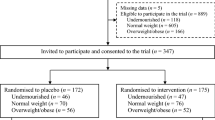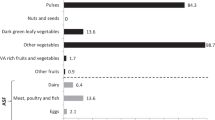Abstract
Objective: To assess the nutritional status of Tarahumara children at indigenous boarding schools.
Design: Cross-sectional comprehensive nutritional survey.
Setting: The schools sampled were located in indigenous municipalities of the northern Mexican state of Chihuahua.
Subjects: The study was carried out in 2001 among 331 children aged 6–14 y from a sample of five schools. Anthropometric measurements, a thyroid exam and capillary haemoglobin levels were obtained from the children. Serum concentrations of ferritin, iron, total iron-binding capacity, vitamin B12, folic acid and zinc were collected from a subsample of 100 children.
Results: The prevalence of wasting and overweight (children 6–9 y) was 1.1 and 4.6%, respectively, and of underweight, risk of overweight and overweight (10–14 y) was 3.2, 5.1 and 0.6%, respectively. Stunting (6–12 y) was present in 22.3% of the children. The total goitre rate was 5.4%. The prevalence of anaemia was 13% (boys 11.4, girls 14.5%). Overall, 24.2% of the children were iron deficient (depletion 11.1%, deficient erythropoiesis 3%, iron deficiency anaemia 10.1%). No child had folic acid values <3 ng/ml, but 20.2% had low (<200 μg/dl) and 27.3% marginal (200–300 μg/dl) vitamin B12 levels, and 80.2% had low zinc concentrations (<60 μg/dl).
Conclusions: Nutritional underweight and stunting were similar to those reported in rural localities at the national level, but overweight was less prevalent in children aged 10–14 y. Various micronutrient deficiencies was identified including zinc and vitamin B12, but the prevalence of iron and folic acid deficiency was lower than expected. These results suggest that Tarahumara children attending boarding schools may be the better-off children from these extremely poor and marginalized areas.
Sponsorship: Swedish Agency for Research Cooperation with Developing Countries and the Mexican Social Security Institute.
This is a preview of subscription content, access via your institution
Access options
Subscribe to this journal
Receive 12 print issues and online access
$259.00 per year
only $21.58 per issue
Buy this article
- Purchase on Springer Link
- Instant access to full article PDF
Prices may be subject to local taxes which are calculated during checkout
Similar content being viewed by others
References
Allen LH, Rosado JL, Casterline JE, Martínez H, López P, Muñoz E & Black AK (1995): Vitamin B-12 deficiency and malabsorption are highly prevalent in rural Mexican communities. Am. J. Clin. Nutr. 62, 1013–1019.
Brown KH & Wuehler SE (2000): Zinc and Human Health. Results of Recent Trials and Implications for Program Interventions and Research. Ottawa: Micronutrient Initiative and International Development Research Centre.
Brown KH, Peerson JM & Allen LH (1998): Effect of zinc supplementation on children's growth: a meta-analysis of intervention trials. Bibliotheca Nutrit Dieta 5, 76–83.
Centers for Disease Control and Prevention (1989): Criteria for anemia in children and childbearing age women. Report No. 38. Atlanta: CDC.
Cogill B (2001): Anthropometric Indicators Measurement Guide. Food and nutrition technical assistance project. Washington: Academy for Educational Development.
Cohen JH & Hass JD (1999): Hemoglobin correction factors for estimating the prevalence of iron deficiency anemia in pregnant women residing at high altitudes in Bolivia. Pan. Am. J. Public Health 6, 392–399.
Cook JD, Finch CA & Smith NJ (1976): Evaluation of the iron status of a population. Blood 48, 449.
Cook JD, Baynes RD & Skikne BS (1992): Iron deficiency and the measurement of iron status. Nutr. Res. Rev. 5, 189–202.
Dallman PR, Reeves JD, Driggers DA & Lo EY (1981): Diagnosis of iron deficiency: the limitation of laboratory tests in predicting the response to iron treatment in 1-year-old infants. J. Pediatr. 98, 376–381.
Dallman P, Looker A, Johnson C & Carroll M (1996): Influence of age on laboratory criteria for the diagnosis of iron deficiency anemia and iron deficiency in infants and children. In Iron Nutrition in health and Disease, eds. L Hallberg, N Asp, pp 65–74. London: John Libbey.
English RM & Bennett SA (1990): Iron status of Australian children. Med. J. Aust. 152, 582–586.
Expert Scientific Working Group (1985): Summary of a report on assessment of iron nutritional status of the United States population. Am. J. Clin. Nutr. 42, 1318–1330.
Food and Agriculture Organization, World Health Organization (1988): Requirements of Vitamin A, Iron, Folate and Vitamin B12. Food and Nutrition Series, no. 23. Rome: FAO.
Fernández P (1992): La mortalidad infantil indígena en 1990: Una estimación a través de los municipios predominantemente indígenas. México, DF: SSA-CEPS.
Figueroa-Sandoval J, Vaz-Pinto A & Sánchez-Medal L (1975): Anemias megaloblásticas: algunos datos sobre su frecuencia en México. Rev. Invest. Clin. 27, 121–126.
Florentino RF & Guirriec RM (1984): Prevalence of nutritional anemia in infancy and childhood with emphasis on developing countries. In Iron Nutrition in Infancy and Childhood, ed. A Stekel, pp 61–74. New Aran: Raven Press.
Hallberg L, Brune M & Rossander L (1986): Effect of ascorbic acid on iron absorption form different types of meals. Hum. Nutr. Appl. Nutr. 40, 97–113.
Hallberg L, Bengtsson C, Lapidus L, Lindstedt G, Lundberg PA & Hulten L (1993): Screening for iron deficiency: an analysis based on bone-marrow examinations and serum ferritin determinations in a population sample of comen. Br. J. Haem. 85, 787–798.
Hambidge KM (1987): Zinc. In Trace Elements in Human and Animal Nutrition, ed. W Mertz, pp 1–137. San Diego, FL: Academic Press.
Hetzel SB (2000): Iodine and neuropsychological development. J. Nutr. 130, 493S–495S.
International Council for the Control of Iodine Deficiency Disorders, United Nations Children's Fund, World Health Organization (2001): Assessment of Iodine Deficiency Disorders and Monitoring their Elimination. Geneva: ICCIDD, WHO, UNICEF.
Instituto Nacional de Estadística, Geografía e Informática (2001): XII Censo General de Población y Vivienda 2000. Aguascalientes, México: INEGI.
Instituto Nacional Indigenista (2002): Programas y proyectos del Instituto Nacional Indigenista: Dirección de Operación y Desarrollo. Programa de Albergues Escolares Indígenas (alimentación): Instituto Nacional Indigenista, México. Internet site in Spanish at: http://www.ini.gob.mx/ini/progra05_1.html.
Lindenbaum J, Savage DG, Stabler SP & Allen RH (1990): Diagnosis of cobalamin deficiency: II. Relative sensitivities of serum cobalamin, methylmalonic acid, and total homocysteine concentrations. Am. J. Hematol. 34, 99–107.
Lozoff B (1988). Behavioural alteration in iron deficiency. Adv. Pediatr. 6, 331–359.
Martínez-Salgado H, Castañeda-Limones R, Lechuga-Martín del Campo D, Ramos-Hernández Orozco-López M, Rivera-Dommarco J, Mendoza I & Magos C (2002). Deficiencia de yodo y otros posibles bociógenos en la persistencia del bocio endémico en México. Gac. Med. Mex. 138, 149–156.
Monárrez J & Martínez H (2000): Prevalence of malnutrition in Tarahumara children under 5 years in the municipality of Guachochi, Chihuahua. Salud Publica Mex. 42, 8–16.
Monárrez-Espino J & Greiner T (2000): Anthropometry in Tarahumara Indian women of reproductive age in Northern Mexico: is overweight becoming a problem? Ecol. Food Nutr. 39, 437–457.
Monárrez-Espino J, Martínez H & Greiner T (2001): Iron deficiency anemia in Tarahumara women of reproductive-age in northern Mexico. Salud Publica Mex. 43, 392–401.
Morris SS, Ruel MT, Cohen RJ, Dewery KG, De la Briere B & Hassan MN (1999): Precision, accuracy, and reliability of hemoglobin assessment with use of capillary blood. Am. J. Clin. Nutr. 69, 1243–1248.
Murphy SP, Calloway DH & Beaton GH (1995): Schoolchildren have similar predicted prevalences of inadequate intakes as toddlers in village populations in Egypt, Kenya, and Mexico. Eur. J. Clin. Nutr. 49, 647–657.
National Center for Health Statistics (1977): NCHS growth curves for children, birth- 18 years. Publication No. PHS 78-1650. Washington, DC: Department of Health, Education and Welfare.
National Center for Health Statistics (2002): 2000 CDC growth charts for the United States: methods and development. Vital Health Stat 11(246).
National Committee for Clinical Laboratory Standards (1998): Determination of serum iron, total iron-binding capacity and percent transferring saturation; Approved standard. Document H 17-A. Wayne, PA: NCCLS.
Preziosi P, Hercberg S, Galan P, Devanlay M, Cherouvrier F & Dupin H (1994): Iron status of a healthy French population: factors determining biochemical markers. Ann. Nutr. Metab. 38, 192–202.
Rivera-Dommarco J, Shamah-Levy T, Villalpando-Hernández S, González-Cossío T, Hernández-Prado B & Sepúlveda J (2001): Encuesta Nacional de Nutrición 1999. Estado nutricio de niños y mujeres en México. Cuernavaca, México: Instituto Nacional de Salud Pública.
Sauberlich HE (1977): Detection of folic acid deficiency in populations. In Folic Acid: Biochemistry and Physiology in Relation to Human Nutritional Requirement, eds. HP Broquist, CE Butterworth, C Wagner, pp 198–208. Washington, DC: National Academy of Sciences. Food and Nutrition Board pp 213. Washington, DC: National Academy of Sciences.
Smith JC, Butrimovitz GP & Purdy WC (1979): Direct measurement of zinc in plasma by atomic absorption spectroscopy. Clin. Chem. 25, 1487–1491.
Snow CF (1999): Laboratory diagnosis of vitamin B12 and folate deficiency. Arch. Intern. Med. 159, 1289–1298.
Turnlund JR, King JC, Keyes WR, Gong B & Michel MC (1984): A stable isotope study of zinc absorption in young men: effects of phytate and cellulose. Am. J. Clin. Nutr. 40, 1071–1077.
Walter T (1996): Effect of iron deficiency anemia on cognitive skills in infancy and childhood. In Iron Nutrition in Health and Disease, eds. L Hallberg L, N Asp, pp 219–229. London: John Libbey.
World Health Organization (1995): Physical Status: The Use and Interpretation of Anthropometry, pp 161–262. Geneva: WHO.
World Health Organization (1996): Trace Elements in Human Nutrition and Health. Zinc, pp 72–104. Geneva: WHO.
Yip R, Johnson C & Dallman PR (1984): Age-related changes in laboratory values used in the diagnosis of anemia and iron deficiency. Am. J. Clin. Nutr. 39, 427–436.
Acknowledgements
We thank the Tarahumara schoolchildren for their participation, the INI schools' personnel for their assistance during the fieldwork and the Mexican Council for Science and Technology (CONACyT) for financially supporting the primary researcher's training.
Author information
Authors and Affiliations
Contributions
Guarantor: J Monarrez-Espino.
Contributors: JME was the research coordinator and main writer, and was involved in the entire research process. HM contributed to the interpretation of the results and writing of the manuscript. VM contributed to the fieldwork and the interpretation of the results. TG contributed to the study design, interpretation of the results and writing of the manuscript.
Corresponding author
Rights and permissions
About this article
Cite this article
Monárrez-Espino, J., Martínez, H., Martínez, V. et al. Nutritional status of indigenous children at boarding schools in northern Mexico. Eur J Clin Nutr 58, 532–540 (2004). https://doi.org/10.1038/sj.ejcn.1601840
Received:
Revised:
Accepted:
Published:
Issue Date:
DOI: https://doi.org/10.1038/sj.ejcn.1601840
Keywords
This article is cited by
-
High burden of undernutrition among primary school-aged children and its determinant factors in Ethiopia; a systematic review and meta-analysis
Italian Journal of Pediatrics (2020)
-
Burden of intestinal helminths and associated factors three years after initiation of mass drug administration in Arbaminch Zuria district, Southern Ethiopia
BMC Infectious Diseases (2018)
-
Association between the serum concentration of triiodothyronine with components of metabolic syndrome, cardiovascular risk, and diet in euthyroid post-menopausal women without and with metabolic syndrome
SpringerPlus (2014)
-
Overweight with concurrent stunting in very young children from rural Mexico: prevalence and associated factors
European Journal of Clinical Nutrition (2007)
-
Iodine nutrition among indigenous Tarahumara schoolchildren in Mexico
European Journal of Clinical Nutrition (2005)



